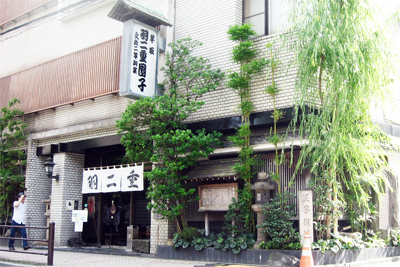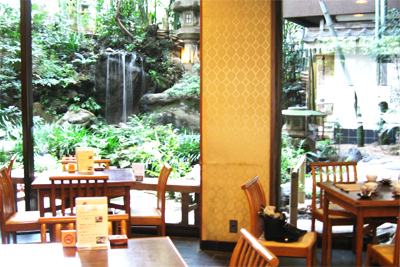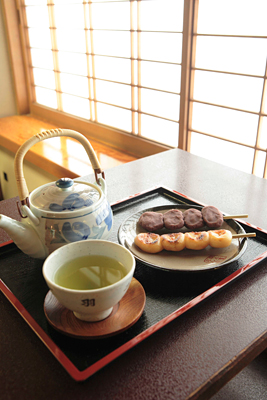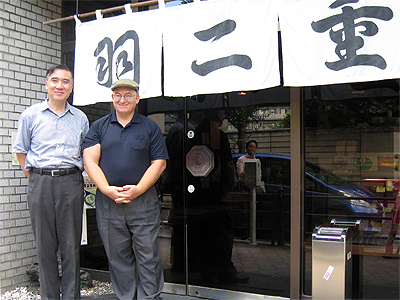 |
セインさん。今日、お訪ねするのは日暮里駅に程近い「羽二重団子」さん。江戸時代の後期、町人文化が爛熟した文政2年(1819)創業のお団子屋さんです。
Thayne-san, today we’re going to visit Habutae Dango near Nippori Station. This is a dango shop that was founded in 1805, a time when the late Edo Period culture of the merchant classes had reached full maturity. |
|
|
|
 |
|
|
|
|
| (澤野) |
ようこそ。セインさん、コンシェルジュさん。羽二重団子の澤野です。さあ、どうぞお入りください。
Good evening Thayne-san, Concierge-san. I’m Sawano, of Habutae Dango. Please come in! |
|
|
 |
わー、外観も素敵なお店ですが、中に入ると素晴らしい中庭が見えるんですね。店内が緑に包まれて、森の中の茶店にいるようです。
Wow, the outside of your shop is beautiful, but there’s a lovely inner garden visible from the entrance! The shop is blanketed in green, making it feel like you’re in a cafe in the middle of a forest. |
|
|
|
 |
|
緑あふれる中庭と、江戸の面影をのこした風情たっぷりの店内。
田山花袋による「羽二重団子」の書。
戊辰戦争の折、敗走の途中、店に逃げ込んだ彰義隊が残していった小刀。
など、歴史資料も展示されている。
The green inner garden and the cafe area retain much of the Edo character.
Calligraphy painted by Tayama Katai.
A wakizashi sword left by a Shogitai soldier during the Boshin War.
The Shogitai hid in the shop while fleeing enemies. |
|
|
| (澤野) |
ありがとうございます。このあたりは、江戸の昔から、加賀様(前田家)のお屋敷があった場所として開ける一方で、水の澄んだ音無川が流れる景色のよい場所ですので、お金持ちが競って別荘を建てた土地柄なんです。
実は、当店は、植木屋だった初代が、自慢の庭をじっくり見ていただきながら一服してもらおうと考えて造った「藤の木茶屋」が始まりなんです。それが“花より団子”で、いつしか庭以上にお団子が人気となりまして……。
Thank you. The residence of Kaga (of the Maeda clan) was located in this area starting in the Edo Period. It’s a beautiful place, with the clear water of the Otonashi River flowing through it, and the rich people of Edo competed to build country houses here as well.
The first generation owner of Habutae Dango was a gardener, and he designed the perfect garden for customers to enjoy while relaxing with a cup of tea. In fact, the shop was originally called “Fuji-no-ki Chaya,” or “Wisteria Tea Shop.” But before he knew it, the dango became more popular than the beauty of the garden, just like an old Japanese saying goes. |
|
|
  |
(笑)。
How funny! |
|
|
| (澤野) |
“花より団子”ということわざがあるくらいですから、当時、団子はとてもポピュラーな食べ物だったんです。
You know dango must have been a popular food for the expression “Dango before flowers,” to catch on. |
|
|
 |
そして、江戸以後も現在まで、ずっとご繁盛ということですね。
セインさん、羽二重団子は、有名な小説家や歌人がいろいろな作品に登場させているんですよ。
And your shop has been doing very well ever since!
Thayne-san, Habutae Dango has appeared in a lot of different works by famous novelists and poets. |
|
|
| (澤野) |
夏目漱石の『吾輩は猫である』という小説の中に、「行きませう。上野にしますか。芋坂へ行って團子を食いましょうか。」と出てくる「芋坂の団子」というのが、羽二重団子のことです。ほかに泉鏡花、久保田万太郎、正岡子規、舟橋聖一、司馬遼太郎といった先生方が小説やエッセイに書いたり、俳句に詠んだりしてくださっています。
セインさんも、どうぞ召し上がってみてください。
That’s true. In Natsume Soseki’s novel I am a Cat, one of the characters says, “Let’s go. To Ueno, say? Shall we have dango at imozaka?” “Dango at Imozaka” refers to our dango. Other authors and poets who have mentioned us in their novels, essays and haiku include Izumi Kyoka, Kubota Mantaro, Masaoka Shiki, Funahashi Seiichi, and Shiba Ryotaro. |
|
|
|
 |
|
|
 |
おいしいですね~! 作り方は昔と変わらないのですか?
Mmm, delicious! Has your recipe changed much since the old days? |
|
|
| (澤野) |
ところどころ機械の力を借りていますが、基本的には変わりません。羽二重団子は、選び抜いた米の粉を湯でこね、蒸して、よく搗くというシンプルなものです。 「よそが300回搗くなら、うちは600回搗け」と言われたほどで、よく搗くことでキメ細かく、艶のある、粘りとシコシコした歯触りのある生地になります。それを丸めたものを、手で平たく押しつぶして串を差します、こればかりは手作業でないとできません。
We make use of machines here and there, but basically our process hasn’t changed. We use only select rice flour, which we knead with oil, steam, and then pound. There’s not much to it.
Our shop’s rule has been, “If other shops pound their dough 300 times, we have to pound ours 600 times!” By pounding the dough thoroughly, the texture becomes very fine, and takes on a sticky, chewy quality. We take that round ball of dough and press it down by hand to make it flat, and then attach them to a skewer. This much of the process has to be done by hand. |
|
|
 |
漉し餡の団子と、お醤油をつけて焼いた団子の2種類があるのがいいですね。飽きずにいくらでも食べられます。
It’s nice that you have two types: the koshian red bean paste dango and the grilled dango with soy sauce. You can eat a lot without getting tired of them. |
|
|
| (澤野) |
はい。どうぞ何本でもお代わりしてください(笑)。
昔は、皆さま、3本、4本と召し上がったのですが、最近は2本でも多いと言われるお客様も多くて、2個刺しのものもご用意するようになりました。 それに、江戸時代に多分、江戸に数えきれないほどあった団子屋が、今は数軒になってしまいました。だからこそいよいよ、団子という、日本人の郷愁を呼び起こす菓子を、この何ともいえないおいしさを、店の風情とともに未来に伝えていかなければならないと思っているんです。
Indeed. Please, help yourself to seconds and thirds.
In the past, everyone ate three of four skewers of dango, but these days many customers say that even two skewers is too many, so we’ve started offering skewers with only two dango each.
Although in the Edo Period dango shops were too numerous to count, these days there are just a few left. That’s why I believe that dango, with its wonderful taste and ability to arouse nostalgia in Japanese, are something we have to pass on to future generations, along with the Edo Period-atmosphere of the shop. |
|
|
 |
羽二重団子のほかに、新しい商品を出すといったことはあまり考えませんか?
Have you thought about offering other products, in addition to Habutae dango? |
|
|
| (澤野) |
「しづくあん」という、串に刺さないお団子を作っていて、お土産の人気商品になっています。でも、当店のベースは、あくまでも羽二重団子です。6代目当主の父からも、「手を広げるな」と言われています。
Well, we do make dango that are not put on a skewer, called shizuku-an, and they are popular for giving as gifts. However, our mainstay is always going to be Habutae dango. My father, who was the sixth-generation owner, told us, “Don’t lose your focus.” |
|
|
 |
家訓ですか。
Is that one of your family precepts? |
|
|
| (澤野) |
ええ。「一品商い」として、他に浮気をするなとか、早寝早起きしろとか、いくつかあるんです。
It is. One is to do business with one product, and not to mess around with other things. Another is to be early to bed and early to rise. |
|
|
 |
どの言葉も、日々の仕事を丁寧に大事にしなさい、ということを伝えているんですね。
It seems like he wanted you to focus on your day-to-day work. |
|
|
| (澤野) |
そうですね。羽二重団子は、特に生醤油をつけて焼いている「焼き」の団子は、1日しか持ちません。食品としては技術的に3日、4日と持たせることもできるでしょうが、それはしません。味はその日限りの命ですから。ですから、その味を守っていこうと思ったら、実際、手は広げられません。
Habutae dango, and especially the grilled dango with fresh soy sauce, don’t last more than a day. We could probably technically make them last three or four days, but we don’t want to do that. The taste just isn’t the same after the first day. So if we want to keep the taste of our dango up to high standards, in reality we can’t very well expand our business into other products. |
|
|
 |
欧米型の経営拡大をめざすビジネスとは違う発想のなかで、こういう歴史を感じさせる素敵な店が、いまここにあるんですね。
Although your philosophy may not follow Western business models for growth, you have a wonderful shop with an amazing history. |
|
|
| (澤野) |
はい、おかげさまで。どうか、ゆっくりくつろいでいってください。
Thank you. Please, take your time and relax before you go. |
|
|
  |
今日はありがとうございました。
Thanks so much for your time today. |
|
 |
|
(文)太田美代
(英訳)デイビッド・A・セイン |
 1959年、米国生まれ。証券会社勤務を経て来日し、翻訳・通訳など多岐にわたって活躍。豊富な教授経験を生かし、数多くの英語関係書籍を執筆。近著に『日本人のチョットへんな英語』(アスコム)、『超入門シャドーイング』(主婦の友社)、日本人が使いすぎる英語(PHP文庫)など多数。
1959年、米国生まれ。証券会社勤務を経て来日し、翻訳・通訳など多岐にわたって活躍。豊富な教授経験を生かし、数多くの英語関係書籍を執筆。近著に『日本人のチョットへんな英語』(アスコム)、『超入門シャドーイング』(主婦の友社)、日本人が使いすぎる英語(PHP文庫)など多数。










